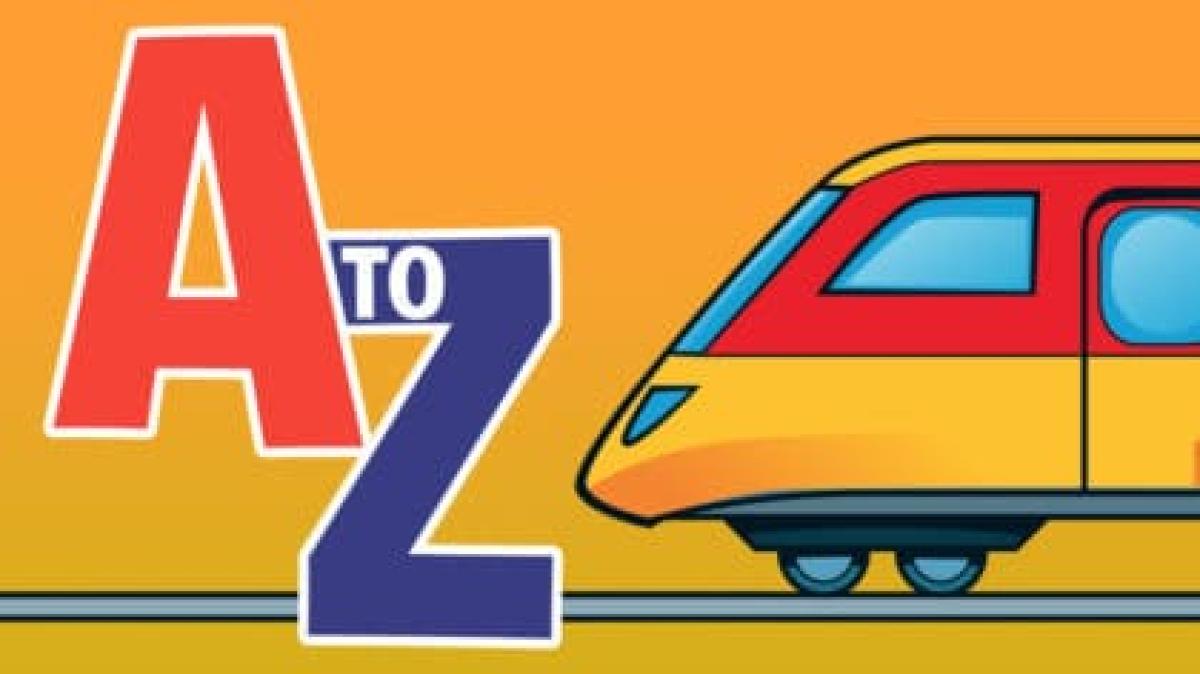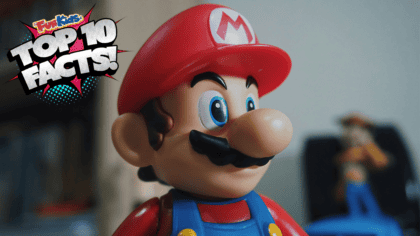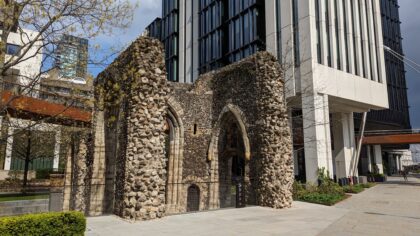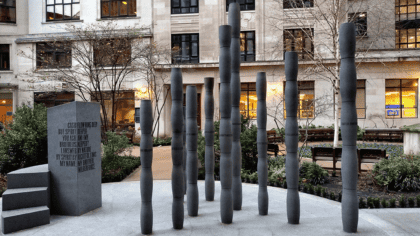Bex and Dan found out many things about the railways when on their tour!
They’ve made a list of some of the facts to help you…

Alternating current
The electric current that flows alternatively through each wire in a rapid sequence. Standard UK mains electricity supply is powered by alternating current or AC.

Ballast
A bed of pebbles placed around the railway track. Its main role is to transmit the stresses, generated by the passage of trains, to the ground, without the latter becoming packed down or deformed.
But it also makes it possible to reduce the vibrations caused by trains and to prevent vegetation from growing on the tracks. Although some tracks are now built without ballast, ballast remains a key component for the vast majority of railway infrastructure.

Big Four
You may have heard this term that refers to the four train operating companies that were formed on 1 January 1923 to run passenger and freight trains in the UK.
The four companies were the London Midland and Scottish Railway, the London and North Eastern Railway, the Great Western Railway and the Southern Railway. They were combined to form British Railways in 1948.

Bogie
A component found in all types of trains (locomotive, wagon, metro, tram, etc.). A bogie is a frame, placed under the trains, onto which the wheels of the railway vehicle are fixed. As bogies are mobile in relation to the frame of the vehicle itself, they can notably be used to facilitate movement on curved tracks.

Carriage
A towed vehicle designed to move along a railway track. Unlike wagons, which are used for transporting goods, carriages transport people.
There are several types of carriage, depending on use – passenger carriages, buffet carriages, sleeper carriages…

Catenary
One of the most well-known elements of railway infrastructure, as they are amongst the most visible.
They are the collections of cables and their supports. They hold wires above the tracks which supplying trains with electricity via a pantograph.

Chair
A metal support that holds the rail in place and is bolted, spiked or clipped to the sleepers.

Check Rail
A rail inside the running rails seen on curves and points to keep the flanges of the wheels from riding up on the opposite rail.

Colour Light Signal
Any signal that uses only coloured light to provide an indication of how far in front of the train the line is clear.

Cutting
A section of railway line where the surrounding countryside is at a higher level than the line and the ground has been dug away to maintain the line at a constant level.

Fishplate
A piece of metal bolted onto the rails, making it possible to connect two rails in a row. Fishplates are often used near switches or other sensitive areas. Elsewhere, the joints between two rails are generally welded.

Four Aspect Signal
A colour light signal using for lights. From top to bottom, the lights are yellow, green, yellow and red.
Red means the next section contains a train. A signal yellow light using the lower yellow aspect means the next section is clear but there is a train in the following one.
A double yellow means the next two sections are clear but there is a train in the third section green means at least the next three sections are clear.

Gauge
Gauge is the overall set of dimensions represented by the external contours of a railway vehicle. The gauge ensures that the train can circulate, taking into consideration obstacles near the track.
As trains cannot deviate from the track, gauge is very important to help ensure obstacles are not hit.
In 1825, George Stephenson chose a track gauge of 4 feet 8½ inches, or 1,435 mm. While this spacing has become the norm in many countries, it has since been modified in some areas – it’s 1,000 mm in South America and parts of Africa, 1,067 mm in southern Africa, 1,520 mm in Russia and Eastern Europe, 1,668 mm in Spain and Ireland.
Click here to find out more about the people that built the railways!

Hold-down clip
A curved piece of metal, placed on either side of the rail, to attach the rails onto the sleepers.

Loading gauge
The size limit for locomotives and rolling stock over a specific stretch of railway.
This is measured horizontally and relation to position of platform edges and tunnel walls and vertically in relation to bridge and tunnel Heights.
The loading gauge can vary considerably for the same track gauge especially and Europe and North America. Until the 1960s, you would often see a frame suspended over the track in freight yards to indicate the limit to which a wagon may be safely loaded.

Merry-go-round
Merry-go-round trains began in the early 1960s and describe trains supplying coal to power stations.
MGR trains consist of hopper wagons, fast loading of coal from the storage bunker at a colliery and automatic discharge over a power station’s receiving hopper.
The advantages of MGR trains are that they eliminate the need for extra locomotives and wagons and also extra sidings for loading and unloading coal.

Multiple unit
A set of couches which has self powered and have a driving compartment at each end. Multiple units are usually powered by electric motors or diesel engines although a new generation of self powered electric trains fuelled by hydrogen or batteries is being developed.

Pantograph
A key component of electric trains. Placed on the roof at regular intervals along the entire length of the train, these spring loaded devices are used to pick-up electrical current by rubbing against the catenaries, before transmitting in onwards to the traction system.

Push Pull
A type of train where the carriages are permanently coupled to a locomotive which pulls them in one direction, then pushes them in the other. You can see these type of trains on the East Coast Main Line and in East Anglia.
Q Train
A special train manned by British Transport Police officers that can be stopped at any time to deal with cases of vandalism, trespass or other crimes on the railway.
Rails
Undoubtedly the most well-known element of railway infrastructure.
They are steel bars placed end-to-end in two parallel lines all along the railway tracks.
They serve as a guide and a support for the trains, and can also be used for the transmission of electrical signals.

Rolling Stock
Anything with wheels which can run on the track including carriages, freight wagons and maintenance vehicles.
Signals
Part of the railways ‘highway code’. They often include traffic lights which tell trains when to reduce speed or stop.
Only one train is allowed on a certain piece of track at the same time to ensure there are no collisions. You might spot speed signs which indicate the maximum speed that can be safely reached.
Semaphore Signals use a moving arm to indicate the state of the line ahead. If the signal points horizontally this indicates that the next section contains a train. A raised or lowered arm indicates the line is clear. The arm also has coloured filters which move in front of a lamp when the signal arm moves to help drivers see the signal at night.
Colour Aspect Signals use coloured lights and are the most common signal that you see. A red light means the next section contains a train, a yellow light means the next section is clear but there is a train in the one after that, and a green indicates the next two sections are clear.

Signal Box
A building from which the surrounding points and signals are operated. It may contain either a lever frame or in more modern signal box is a panel containing switches and coloured lights.
Sleepers
Essential components of railway infrastructure, helping to maintain the correct width of the rails and provide stability to the track. They are laid across the track under the rails, and are made of wood or concrete.
Toilets
An important room on any train journey!
Train toilets are changing a lot – with many more features like hand dryer, soap dispenser, baby-changing tables etc.
There are 3 main types of train toilets – open toilet bowls that empty onto the track (yuck!), chemical toilets and clean water toilets. Today the waste from the toilet are stored on board and emptied when the train is in the station.

Track circuit
Part of the traffic detection system. This device, fitted to the rails, applies an electrical voltage to a given section of rail. When a train passes by, this causes a short-circuit which helps detect the entry of a train in that particular section.

Traction system
The traction system converts the electrical energy, collected from the catenary via the pantograph, into mechanical energy to turn the wheels.
You will find them either installed on the roof or underneath the train.

Train set
A collection of vehicles (carriages or wagons) that are connected together. It can be self-propelled or pulled by a locomotive.
Tram-train
This is a special type of train that moves through busy streets on special tracks as well as on the mainline railway.
Wagon
A towed vehicle designed to move goods and freight.
Depending on what is being carried, these vehicles could include refrigerated wagons, tanker wagons, crane wagons, container wagons…

Wheelset
A wheelset consists of an axle shaft and the wheels. They are mounted on the train’s bogies, and they allow the trains to move.
They work on the same principle as the wheelsets on your car or the local bus.
Zookeeper
A nickname for a railway man or woman who check tickets at station barriers.
Find out more about Britain’s railways!
Bex and Dan from Fun Kids learn all about the future of Britain’s railways, from signals to trains and tracks, in this new podcast series!
 Britain’s Digital Railways, in association with the Royal Academy of Engineering Ingenious scheme
Britain’s Digital Railways, in association with the Royal Academy of Engineering Ingenious scheme
Add a commentBritain’s Digital Railways
Find out about Britain's railways - from signals and trains to tracks and safety!
More From Britain’s Digital Railways






